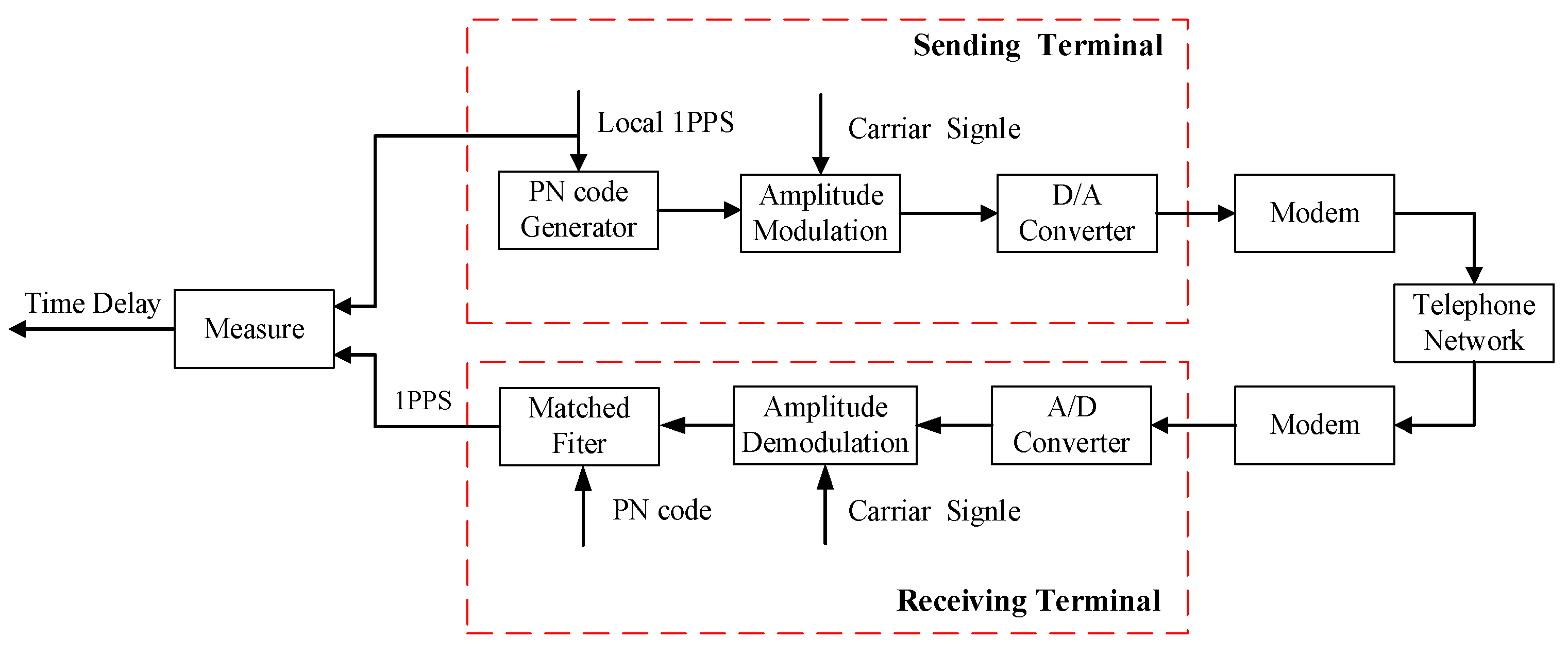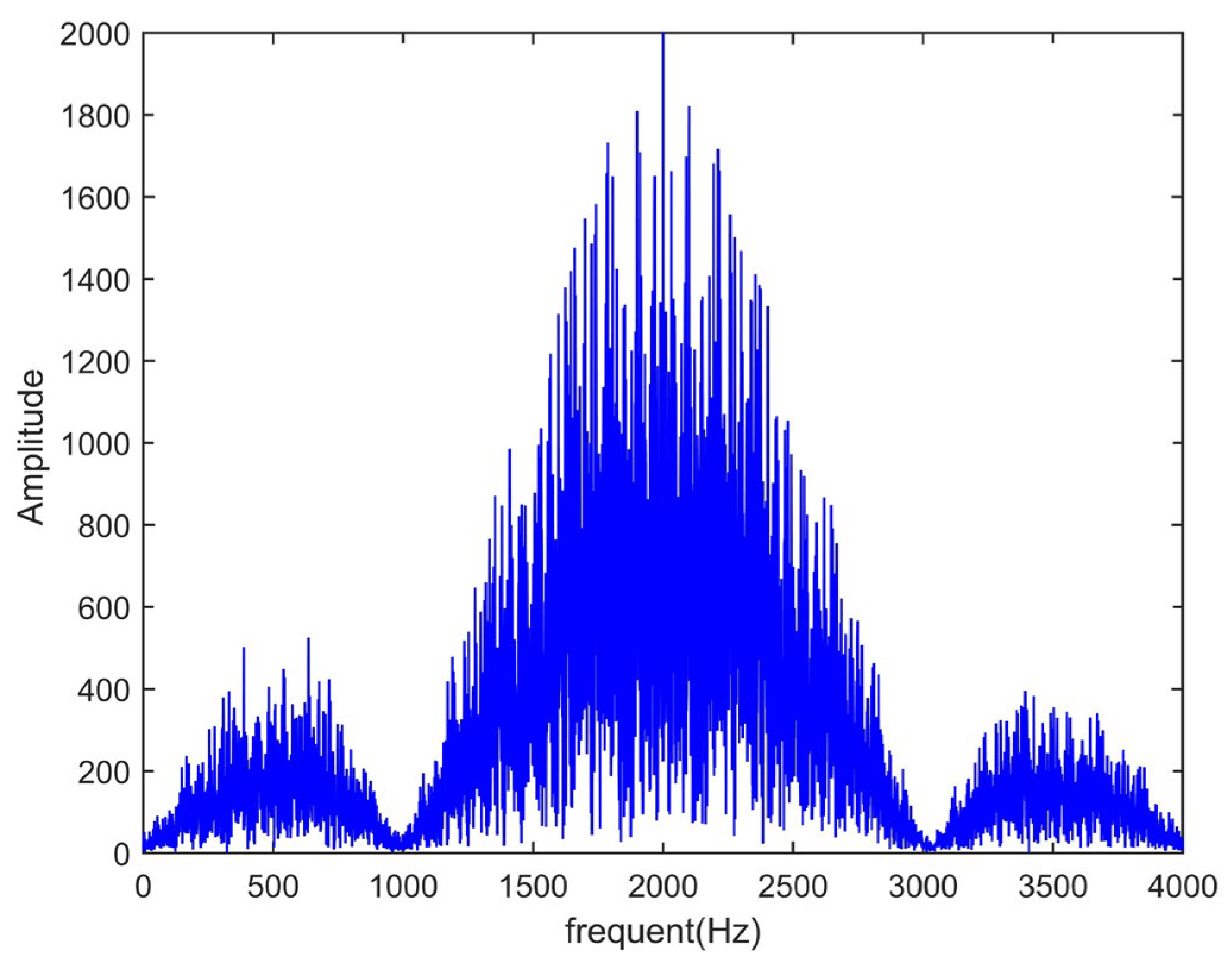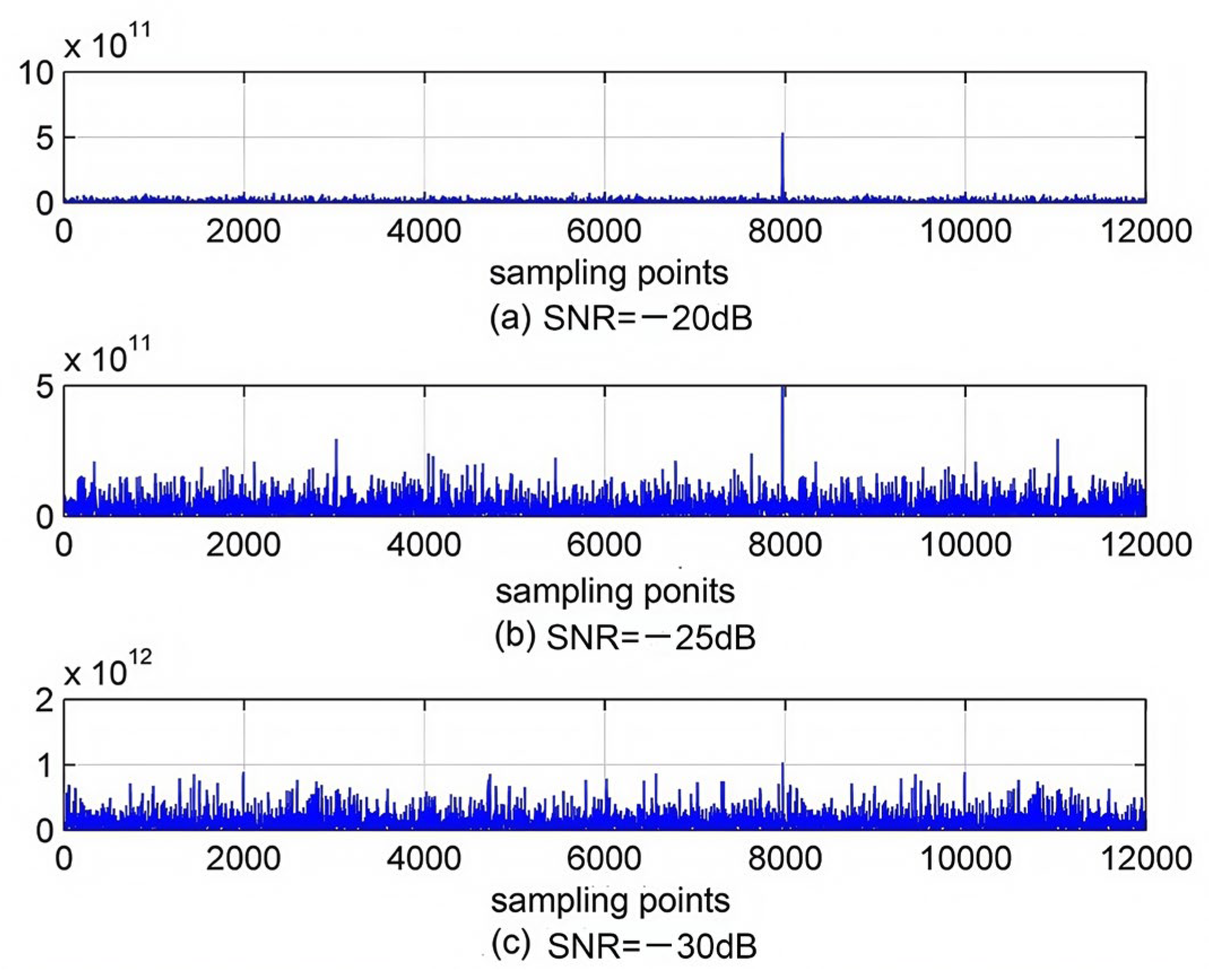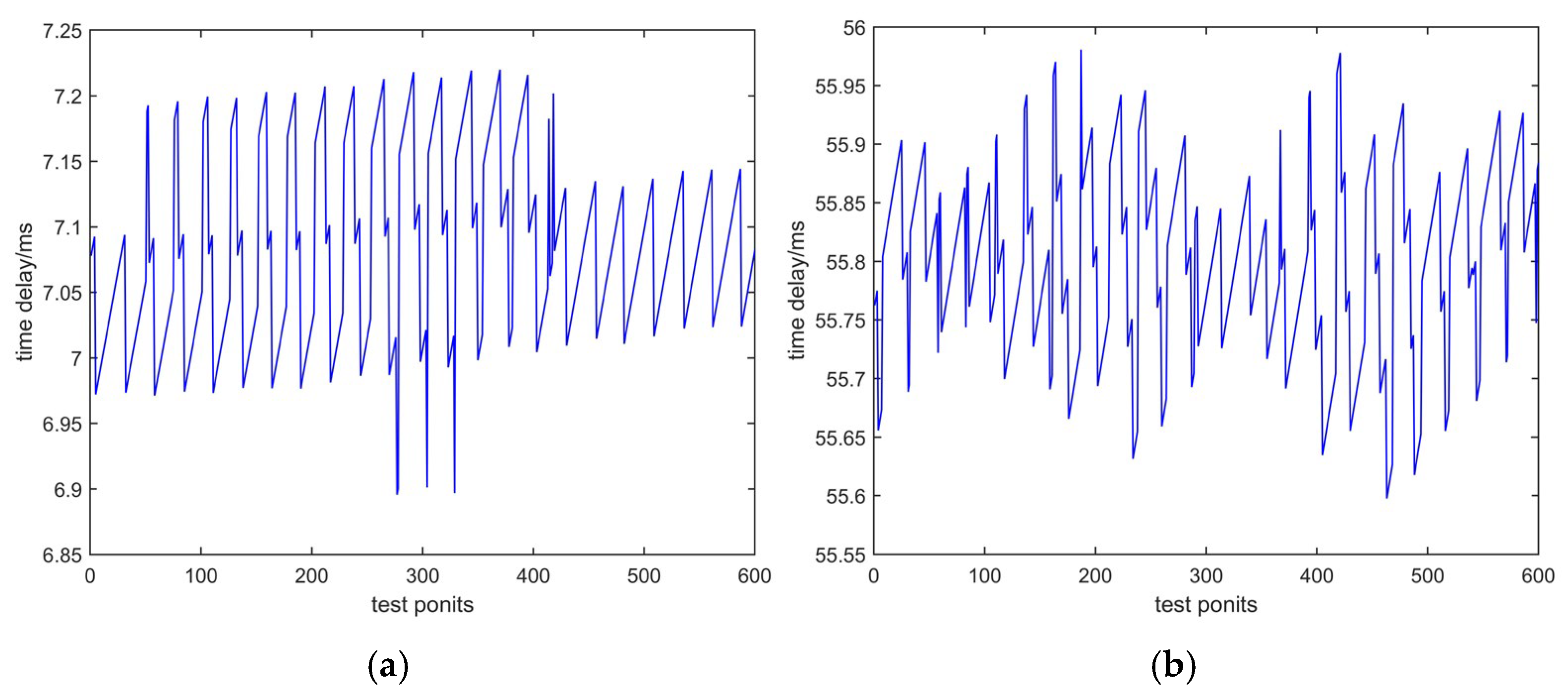Application of PN Code in Time Delay Measurement of Telephone Network
Abstract
1. Introduction
2. Materials and Methods
2.1. Measuring Time Delay Based on Sending Characters
2.2. Measuring Time Delay Based on Sending PN Codes
2.2.1. Measuring Principle
2.2.2. Design of PN Codes
2.2.3. Modulation of PN Codes
2.2.4. Demodulation and Capture of PN Codes
- Demodulation of PN codes:
- 2.
- Capture of PN code:
2.3. Materials
3. Results
3.1. Anti-Noise Performance
3.2. Experimental Verification
3.2.1. Verification Method
- Capture verification:
- 2.
- Test platform:
3.2.2. Comparison of Two Methods
3.2.3. Further Verification
- Test based on different telephone networks in the same city:
- 2.
- Measurement in different cities:
4. Discussion
5. Conclusions
Author Contributions
Funding
Institutional Review Board Statement
Informed Consent Statement
Data Availability Statement
Conflicts of Interest
References
- Ke, X.Z.; He, K.Y. Research on Time Synchronization Accuracy of Telephone Time Service System. J. Astronaut. Metrol. Meas. 2000, 20, 27–31. [Google Scholar]
- Kuniyasu, I. Generation, Comparison, and Dissemination of the National Standard on Time and Frequency in Japan. Q. Rep. Intell. Commun. Res. Inst. 2010, 57, 87–95. [Google Scholar]
- Yuan, H.B.; By, Y.; Feng, P.; He, K.Y. Optimal control time service system by using telephone line. In Proceedings of the Joint Meeting of the European Frequency and Time Forum and the IEEE International Frequency Control Symposium, Besancon, France, 13–16 April 1999. [Google Scholar]
- Banerjee, P.; Thorat, P.P.; Suri, A.K. An Innovative Time service via Telephone Network—A study on its Potentiality. In Proceedings of the IEEE International Frequency Control Symposium Joint with the 22nd European Frequency and Time Forum, Besancon, France, 20–24 April 2009. [Google Scholar]
- Poudel, N.; Goel, S.; Sardar, S.; Yadav, S. Towards ± ms accuracy using FonOclock telephone time dissemination system. In Proceedings of the URSI Asia-Pacific Radio Science Conference, New Delhi, India, 9–15 March 2019. [Google Scholar]
- Arora, P.; Acharya, A.; Yadav, S.; Ojha, V.N. A new time dissemination service with an accuracy of ±10 ms over public switched telephone network. In Proceedings of the XXXIInd General Assembly and Scientific Symposium of the International Union of Radio Science, Montreal, QC, Canada, 19–26 August 2017. [Google Scholar]
- Niculescu, A.; Angelescu, M. Time dissemination via telephone lines using commercial modems. In Proceedings of the 18th European Frequency and Time Forum, Guildford, UK, 5–7 April 2004. [Google Scholar]
- Damasceno, J.C.; Couto, P.R.G. Methods for Evaluation of Measurement Uncertainty. In Metrology; IntechOpen: London, UK, 2018. [Google Scholar] [CrossRef]
- Gu, H.Q.; Liu, X.X.; Xu, L.; Zhang, Y.J.; Lu, Z.M. Period Estimation of Spread Spectrum Codes Based on ResNet. Sensors 2023, 23, 7002. [Google Scholar] [CrossRef] [PubMed]
- Wang, W.W.; Tian, Y.; Bian, L.; Wang, G.Y.; Meng, Y.S.; Zhang, L.X. A Novel Satellite PRN Code Assignment Method Based on Improved RLF Algorithm. Sensors 2022, 22, 5538. [Google Scholar] [CrossRef] [PubMed]
- Pérez, I.R.; Lluis, B.X.; Adriano Camps, A.; Alvarez, N.R.; Hernandez, J.F.M. Calibration of Correlation Radiometers Using Pseudo-Random Noise Signals. Sensors 2009, 9, 6131–6149. [Google Scholar] [CrossRef] [PubMed]
- Ammana, S.R.; Songala, K.K.; Bollavula, D. Performance Evaluation of Weil Codes and Gold Codes for Application in Future Navigation Signals. In Proceedings of the IEEE 2nd Mysore Sub Section International Conference, Mysuru, India, 16–17 October 2022. [Google Scholar]
- Zulu, T.S.; Mathonsi, T.E. An Enhanced VoIP Codec Transcoder to Enhance VoIP Quality for IP Telephone Infrastructure. In Proceedings of the International Conference on Computational Science and Computational Intelligence, Las Vegas, NV, USA, 15–17 December 2021. [Google Scholar]
- Deng, Z.L.; Mo, J.; Jia, B.Y.; Bian, X.M. An Acquisition Scheme Based on a Matched Filter for Novel Communication and Navigation Fusion Signals. Sensors 2017, 17, 1766. [Google Scholar] [CrossRef] [PubMed]
- Tong, B.R. Timing System; National Defence Industry Press: Beijing, China, 2003; pp. 137–139. [Google Scholar]
- Kim, S.T.; Ahn, J.M. Analysis of Correlation Characteristics of 10230 Period PRN Code using Concatenated Gold Code. In Proceedings of the International Conference on Electronics, Information, and Communication, Auckland, New Zealand, 22–25 January 2019. [Google Scholar]
- Miet, G.; Gerrits, A.; Valiere, J.C. Low-band extension of telephone-band speech. In Proceedings of the IEEE International Conference on Acoustics, Speech, and Signal Processing, Istanbul, Turkey, 5–9 June 2000. [Google Scholar]
- Laskov, L.B.; Georgieva, V.M. Analysis of Amplitude Modulation and Demodulation in MATLAB Simulink Environment. In Proceedings of the 56th International Scientific Conference on Information, Communication and Energy Systems and Technologies, Sozopol, Bulgaria, 16–18 June 2021. [Google Scholar]
- Li, S.F.; Wang, Y.L.; Hua, Y. A Fast Anti-Interference Detection Method for Loran-C Signal. J. Xi’an Jiaotong Univ. 2013, 47, 91–96. [Google Scholar]
- Galati, G.; Pavan, G.; Savci, K.; Wasserzier, C. Noise Radar Technology: Waveforms Design and Field Trials. Sensors 2021, 21, 3216. [Google Scholar] [CrossRef] [PubMed]
- Zhao, Z.S.; Zhao, A.B.; Hui, J.; Hou, B.C.; Sotudeh, R.; Niu, F. A Frequency-Domain Adaptive Matched Filter for Active Sonar Detection. Sensors 2017, 17, 1565. [Google Scholar] [CrossRef] [PubMed]
- Zhao, Z.S.; Jie, L.; Li, Y.W. Echo Detection Method Based on Matched Filter Using Fast Orthogonal Search. In Proceedings of the OES China Ocean Acoustics, Harbin, China, 14–17 July 2021. [Google Scholar]
- Eldar, Y.C.; Oppenheim, A.V. Orthogonal matched filter detection. In Proceedings of the IEEE International Conference on Acoustics, Speech, and Signal Processing, Proceedings, Salt Lake City, UT, USA, 7–11 May 2001. [Google Scholar]
- Fan, C.X.; Zhang, P.Y.; Xu, B.X.; Wu, C.K. Principles of Communications, 5th ed.; National Defence Industry Press: Beijing, China, 2001; pp. 260–335. [Google Scholar]
- JCGM 100:2008; Evaluation of Measurement Data—Guide to the Expression of Uncertainty in Measurement. Joint Committee for Guides in Metrology: Sèvres, France, 2008.
- Sha, H.Y.; Zhu, L.H. Dynamic analysis of pattern and optimal control research of rumor propagation model on different networks. Inf. Process. Manag. 2025, 62, 104016. [Google Scholar] [CrossRef]
- Li, B.X.; Zhu, L.H. Turing instability analysis of a reaction–diffusion system for rumor propagation in continuous space and complex networks. Inf. Process. Manag. 2024, 61, 103621. [Google Scholar] [CrossRef]
- Yuan, T.Y.; Guan, G.; Shen, S.L.; Zhu, L.H. Stability analysis and optimal control of epidemic-like transmission model with nonlinear inhibition mechanism and time delay in both homogeneous and heterogeneous networks. J. Math. Anal. Appl. 2023, 526, 127273. [Google Scholar] [CrossRef]











| Method | Mean (ms) | Uncertainty (μs) |
|---|---|---|
| Based on sending characters | 66.86 | 42.68 |
| Based on sending PN codes | 3.43 | 3.31 |
| Test Place | Telephone Network | Mean (ms) | Uncertainty (μs) |
|---|---|---|---|
| Same city | PSTN | 7.08 | 2.88 |
| PSTN and VIOP | 55.80 | 3.16 | |
| Different cities | PSTN (Xi’an–Weinan) | 84.69 | 3.35 |
| PSTN (Xi’an–Tianjin) | 131.60 | 4.46 |
Disclaimer/Publisher’s Note: The statements, opinions and data contained in all publications are solely those of the individual author(s) and contributor(s) and not of MDPI and/or the editor(s). MDPI and/or the editor(s) disclaim responsibility for any injury to people or property resulting from any ideas, methods, instructions or products referred to in the content. |
© 2025 by the authors. Licensee MDPI, Basel, Switzerland. This article is an open access article distributed under the terms and conditions of the Creative Commons Attribution (CC BY) license (https://creativecommons.org/licenses/by/4.0/).
Share and Cite
Jin, X.; Hua, Y. Application of PN Code in Time Delay Measurement of Telephone Network. Sensors 2025, 25, 241. https://doi.org/10.3390/s25010241
Jin X, Hua Y. Application of PN Code in Time Delay Measurement of Telephone Network. Sensors. 2025; 25(1):241. https://doi.org/10.3390/s25010241
Chicago/Turabian StyleJin, Xiaozhen, and Yu Hua. 2025. "Application of PN Code in Time Delay Measurement of Telephone Network" Sensors 25, no. 1: 241. https://doi.org/10.3390/s25010241
APA StyleJin, X., & Hua, Y. (2025). Application of PN Code in Time Delay Measurement of Telephone Network. Sensors, 25(1), 241. https://doi.org/10.3390/s25010241





